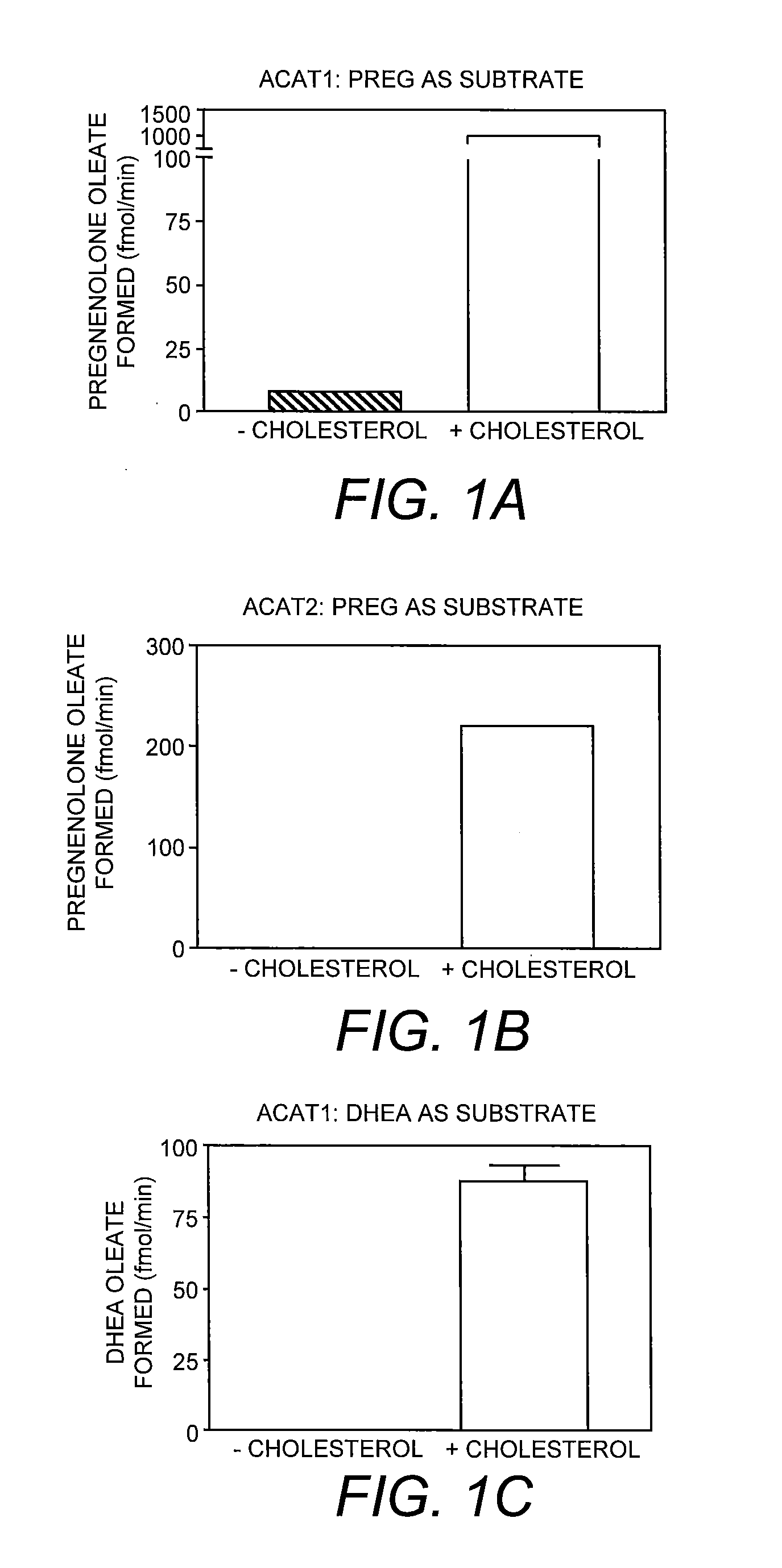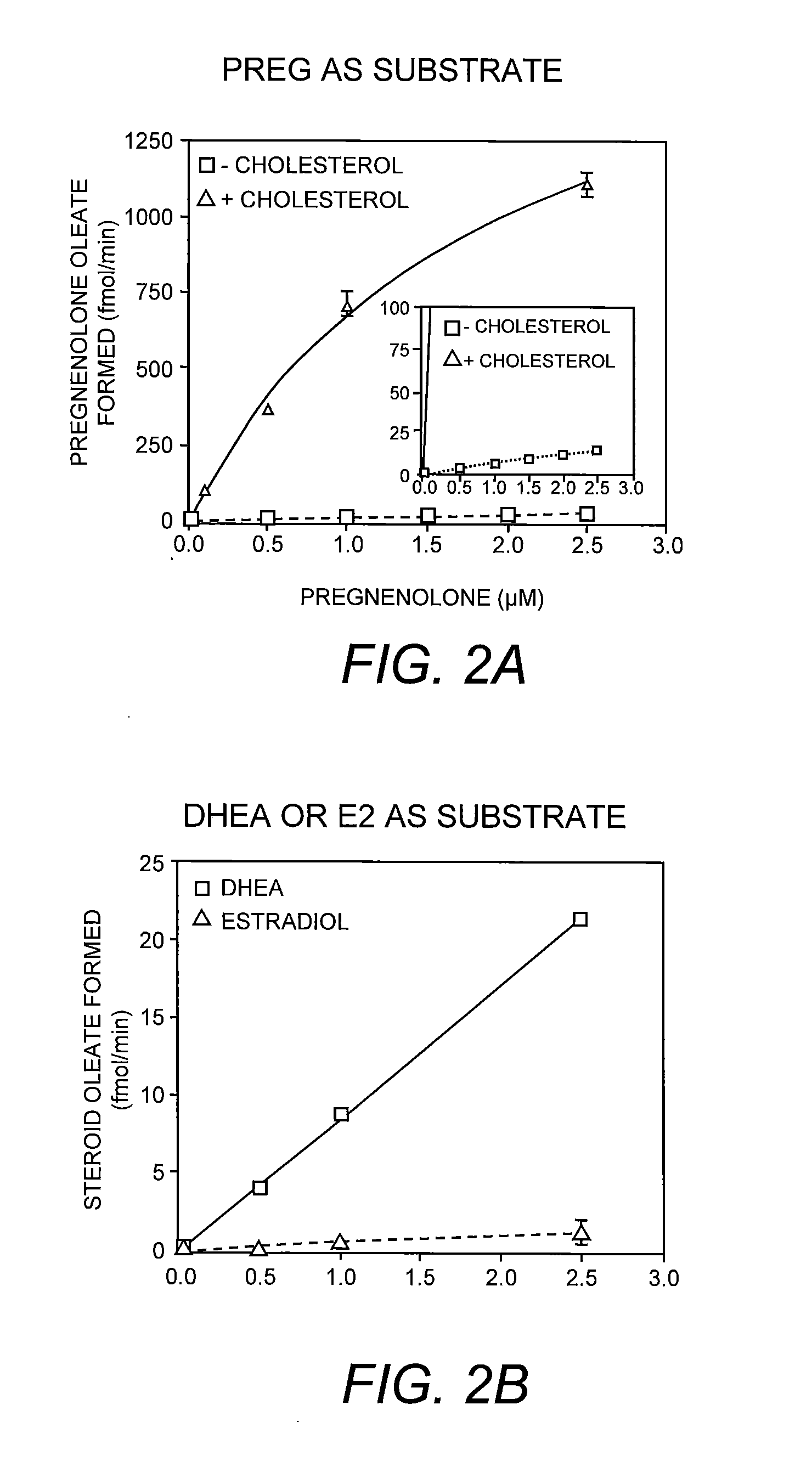Methods for Identifying Allosteric and Other Novel Acyl-Coenzyme A:Cholesterol Acyltransferase Inhibitors
a technology of acylcoenzyme a and acylcoenzyme b, which is applied in the field of methods for identifying allosteric and other novel acylcoenzyme a : cholesterol acyltransferase inhibitors, can solve the problems of membrane deformation in neurons and other cell types, and affect the screening effect, and achieve high throughput screening
- Summary
- Abstract
- Description
- Claims
- Application Information
AI Technical Summary
Benefits of technology
Problems solved by technology
Method used
Image
Examples
example 1
Recombinant ACAT Expression in CHO Cells
[0031]A fragment of the ACAT gene was generated containing an ATG translation initiation codon, codons for a 6-histidine tag that functions as a metal binding domain, a T7 tag that serves as a transcript stabilizing sequence from gene 10 of phage T7, and an enterokinase cleavage recognition sequence (a total of 40 amino acids). This construct (originally designed by Invitrogen for baculovirus transfer vector pBLUEBACHIS) was ligated to the N terminus of hACAT-1 cDNA (nucleotide residues 1397-3046, a total of 550 amino acids, with the first methionine (ATG) converted to leucine (CTA) by site-specific mutagenesis). This entire fragment was then ligated into the expression vector pcDNA3 (Invitrogen). Using a modified calcium phosphate-DNA co-precipitation method (Hasan et al. 1991. Somat. Cell Mol. Genet. 17:513-517), or other method, the plasmid was transfected into an ACAT-deficient cell line, AC29, that lacks endogenous ACAT message and protei...
example 2
Recombinant ACAT Expression in H293 Cells
[0034]Method for Generating the HisACAT1 / FLAG Plasmid and Recombinant H293 Cells.
[0035]To aid in enzyme purification, a conventional FLAG octapeptide was inserted at the C-terminus of HisACAT1 cDNA (Guo, Z. Y. et al. 2005. J. Biol. Chem. 280:37814-37826). This construct (HisACAT1 / Flag) was then ligated into the mammalian expression vector pAG3-Zeo (Ikeuchi, T. et al. 2003. J. Biol. Chem. 278:7010-7018), using the BamHI and ApaI cloning sites. This plasmid was transfected into HEK293S cells; individual stable clones were isolated by selecting cells resistant to zeocin at 400 μg / mL.
[0036]Method for Purifying the HisACAT1 / FLAG Protein.
[0037]HEK293S cells stably expressing HisACAT1 / Flag were seeded in 145 mm dishes for 2-3 days until the cells reached confluency. Cells were rinsed 2× with phosphate-buffered saline (PBS) and harvested by directly solubilizing the cells with buffer A (1 M KCl, 2.5% CHAPS in 50 mM KH2PO4 buffer at pH 7.8; 1 mL / dish)...
example 3
Assay of Pregnenolone Esterification Activity by ACAT In Vitro
[0056]To assay the enzyme, the pregnenolone / detergent / PC micelles and the cholesterol / detergent / PC micelles were prepared individually as follows: the radiolabeled pregnenolone / PC mixture or the cholesterol / PC mixture was prepared as described previously (Shi et al. 1989. Biochim. Biophys. Acta 982:187-195) and lyophilized to remove residual organic solvents. After lyophilization, the detergent sodium taurocholate (or other detergent such as CHAPS) in Buffer A was added to reach a final concentration of 10 mg / ml. The mixture was purged with nitrogen, followed by sonication until this mixture was clear. The pregnenolone / PC micelles were mixed with the cholesterol / PC micelles such that the cholesterol concentration is at 0 mM or at 0.32 mM, and the radioactive pregnenolone concentration is at 1 μM (specific activity 20 Ci / mmol). The start the enzyme reaction, 70-100 μl of mixed micelles containing radioactive pregnenolone, ...
PUM
 Login to View More
Login to View More Abstract
Description
Claims
Application Information
 Login to View More
Login to View More - R&D
- Intellectual Property
- Life Sciences
- Materials
- Tech Scout
- Unparalleled Data Quality
- Higher Quality Content
- 60% Fewer Hallucinations
Browse by: Latest US Patents, China's latest patents, Technical Efficacy Thesaurus, Application Domain, Technology Topic, Popular Technical Reports.
© 2025 PatSnap. All rights reserved.Legal|Privacy policy|Modern Slavery Act Transparency Statement|Sitemap|About US| Contact US: help@patsnap.com



